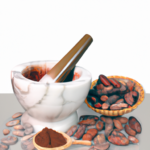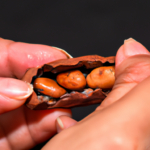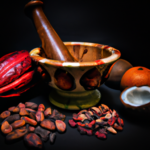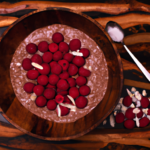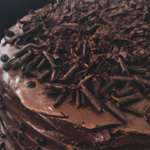Raw Food Ingredients
What Is The Best Way To Grind Raw Cacao Nibs Into Cacao Paste?
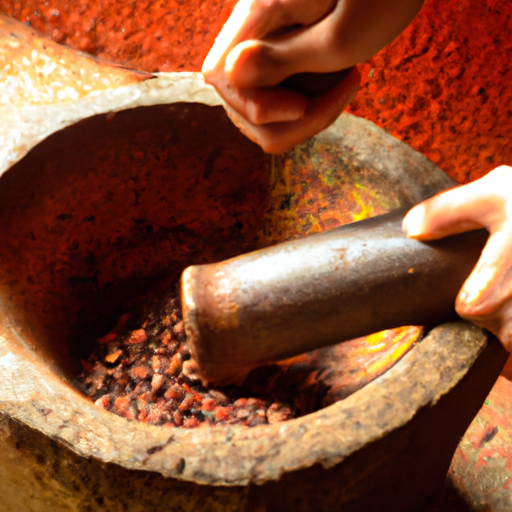
I’ve always been a lover of all things chocolate, but recently, I’ve discovered the joy of working with raw cacao nibs. These little gems have a rich, intense flavor that is unmatched by regular cocoa powder.
However, to fully unlock their potential, I needed to find the best way to grind them into a smooth and creamy cacao paste. Through countless hours of experimentation, I’ve learned the ins and outs of this process.
In this article, I’ll be sharing my findings and guiding you through the steps to achieve the perfect cacao paste. From understanding the characteristics of cacao nibs to choosing the right equipment and experimenting with grinding techniques, we’ll leave no stone unturned.
So, if you’re ready to take your chocolate game to the next level, let’s dive in and explore the best way to grind raw cacao nibs into cacao paste.
Key Takeaways
- Electric grinders are recommended for grinding cacao nibs into paste, with blenders and food processors as alternatives
- Pulse blending allows for better texture control, while longer blending times may generate more heat and alter taste
- Roasting cacao nibs at low temperature intensifies flavor
- Finer grinds create a smoother texture, while coarser grinds give a rustic result
Understand the Characteristics of Cacao Nibs
Now that you’ve got your hands on some cacao nibs, let’s take a moment to understand their unique characteristics.
Cacao nibs have a rich and intense taste profile, with bitter notes and a hint of fruity flavor. They are packed with nutritional benefits, such as antioxidants, fiber, and minerals like magnesium and iron.
When it comes to sourcing and quality factors, it is important to choose organic and fair-trade cacao nibs to ensure their purity and ethical production.
Additionally, the shelf life of cacao nibs can vary depending on storage conditions, but they generally have a long shelf life if stored in a cool and dry place.
Understanding these characteristics will help you choose the right equipment for grinding the cacao nibs into a smooth and creamy paste.
Choose the Right Equipment
When it comes to grinding raw cacao nibs into cacao paste, choosing the right equipment is crucial.
There are two main options to consider: manual and electric grinders. Manual grinders give you more control over the grinding process but require more physical effort, while electric grinders are quicker and easier to use.
Alternatively, blenders and food processors can also be used as alternatives, but they may not provide the same level of precision as dedicated grinders.
Manual vs. electric grinders
To achieve the best results, you should consider using an electric grinder instead of a manual one when grinding raw cacao nibs into cacao paste.
When comparing the cost of manual versus electric grinders, it is important to note that electric grinders are generally more expensive upfront. However, they provide a more efficient and consistent grinding experience, which can save you both time and effort in the long run.
Electric grinders have a higher grinding speed compared to manual grinders, allowing you to achieve a smoother and finer cacao paste in a shorter amount of time. This speed is particularly advantageous when working with larger quantities of cacao nibs.
Moving on to alternative options, blenders and food processors can also be used for grinding cacao nibs, but we will explore these further in the next section.
Blenders and food processors as alternatives
Blenders and food processors can serve as convenient options for transforming cacao nibs into a smooth and creamy paste. When using these appliances, it is important to consider the blending techniques and grinding time to achieve the desired consistency.
| Blending Techniques | Grinding Time |
|---|---|
| Pulse Blending | 2-3 minutes |
| Continuous Blending | 5-7 minutes |
| Low Speed Blending | 8-10 minutes |
By using pulse blending, you can control the texture of the cacao paste more effectively. This technique involves blending the nibs in short bursts to prevent overheating and to maintain the integrity of the cacao’s natural flavors. Alternatively, continuous blending can be used for a smoother and more uniform paste. However, longer blending times may result in increased heat generation, potentially altering the taste of the final product. Once the cacao nibs have been transformed into a paste, it is time to prepare them further for use in various recipes.
Prepare the Cacao Nibs
First, grab your trusty food processor to start preparing those cacao nibs into a smooth and creamy cacao paste. Understanding the origins and sourcing of cacao nibs is crucial in creating a rich and authentic flavor. Ensure that your cacao nibs are of high quality and have been ethically sourced.
Additionally, exploring different roasting techniques can enhance the depth of flavor in your cacao paste. Experiment with different temperatures and durations to find the perfect balance. Begin by preheating your oven and spreading the cacao nibs evenly on a baking sheet. Roast them at a low temperature, around 250°F, for approximately 20 minutes, or until they become fragrant and slightly darker in color. This step is vital in releasing the natural oils and intensifying the flavor of the cacao.
Transitioning into the subsequent section, now that the cacao nibs are perfectly roasted, it’s time to delve into various grinding techniques.
Experiment with Grinding Techniques
Now that you’ve got your perfectly roasted cacao nibs, it’s time to get creative and experiment with different grinding techniques. The fineness of the grind can greatly affect the texture and mouthfeel of your final product. When experimenting, consider the grinding speed and particle size. A faster speed can generate more heat, potentially impacting the flavor and texture. Particle size also plays a role – a finer grind creates a smoother and creamier texture, while a coarser grind gives a more rustic result.
Now, let’s move on to the next section and learn how to adjust the consistency and texture of your cacao paste.
Adjust the Consistency and Texture
When adjusting the consistency and texture of cacao paste, I find that adding a liquid such as cocoa butter or coconut oil helps to achieve the desired results.
The addition of these liquids not only helps to create a smoother and creamier texture but also enhances the overall flavor of the cacao paste.
It is important to grind the mixture until it is completely smooth and free of any lumps or graininess for optimal results.
Adding liquid (e.g., cocoa butter, coconut oil)
To achieve the desired smooth consistency, you may want to consider incorporating a small amount of cocoa butter or coconut oil into the grinding process of your raw cacao nibs. Adding liquid not only helps in achieving the right texture but also enhances the flavor of the cacao paste. When incorporating cocoa butter or coconut oil, it is important to explore different ratios to find the perfect balance of richness and creaminess. Additionally, trying different sweeteners like honey or agave syrup can add a hint of sweetness to the final product. Here is a table showcasing the different ratios and sweeteners you can experiment with:
| Ratio of Liquid to Cacao Nibs | Sweetener |
|---|---|
| 1:1 | Honey |
| 1:2 | Agave |
| 1:3 | Maple |
| 1:4 | Stevia |
| 1:5 | Dates |
By incorporating liquid and experimenting with ratios and sweeteners, you can create a cacao paste that is not only smooth and creamy but also perfectly sweetened. Now, let’s move on to grinding until smooth and creamy.
Grinding until smooth and creamy
To achieve a velvety texture and heavenly consistency, grind your cacao nibs until they transform into a luscious, creamy delight. Implement effective grinding techniques using a high-quality grinder or a stone grinder specifically designed for cacao nibs. This ensures a smooth and even consistency throughout the process. Adjust the paste’s consistency by adding small amounts of liquid, like cocoa butter or coconut oil, for a creamy texture and enhanced flavor profile.
Monitor the grinding process closely to avoid over-grinding, which can result in a grainy texture. Once the desired smoothness is achieved, it’s time to move on to storing and preserving the cacao paste for future use.
Proper storage techniques are crucial to ensure the longevity and freshness of your precious cacao paste.
Store and Preserve Your Cacao Paste
To store and preserve your cacao paste properly, follow these methods:
- Keep your cacao paste in an airtight container to prevent exposure to moisture and air.
- Store it in a cool and dark place, such as a pantry or cupboard, away from sunlight and heat sources.
- Avoid storing it near strong-smelling foods to prevent flavor contamination.
- Consider refrigerating or freezing your cacao paste if you want to prolong its shelf life even further.
By following these guidelines, you can preserve the flavor and texture of your cacao paste, ensuring its freshness for an extended period.
Now, let’s explore flavor variations and discover exciting ways to enhance your chocolate creations.
Explore Flavor Variations
Discover the endless possibilities of flavor combinations that will take your chocolate creations to a whole new level. By exploring different flavor pairings, you can create unique and delicious variations of cacao paste. Not only will this add excitement to your recipes, but it will also allow you to experience the health benefits of various ingredients. To help you get started, here is a table showcasing five flavor variations and their potential benefits:
| Flavor Pairing | Health Benefits |
|---|---|
| Cacao and Coconut | Boosts metabolism and adds a creamy texture |
| Cacao and Mint | Aids digestion and provides a refreshing taste |
| Cacao and Hazelnut | Enhances brain function and adds a nutty flavor |
| Cacao and Orange | Boosts immune system and adds a citrusy twist |
| Cacao and Almond | Supports heart health and adds a subtle nuttiness |
Incorporating these flavor combinations allows you to unlock the full potential of cacao paste in your recipes. Transitioning into the subsequent section, let’s explore how to incorporate cacao paste into various dishes and desserts.
Incorporate Cacao Paste into Recipes
Let’s dive into the creative world of culinary possibilities by incorporating the rich and velvety cacao paste into a variety of mouthwatering recipes. When it comes to incorporating cacao paste into desserts, the possibilities are endless. Here are five ways to elevate your sweet treats with the indulgent flavors of cacao paste:
- Add a dollop of cacao paste to your favorite brownie recipe for an extra fudgy and decadent texture.
- Whip up a creamy chocolate mousse by blending cacao paste with avocado, coconut milk, and a touch of sweetener.
- Infuse your homemade ice cream with cacao paste for a rich and intense chocolate flavor.
- Incorporate cacao paste into your cake batter for a moist and chocolatey delight.
- Create a velvety smooth chocolate sauce by melting cacao paste with coconut cream and a pinch of salt.
In addition to its delicious taste, cacao paste also offers several health benefits. It is rich in antioxidants, which can help reduce inflammation and support heart health. The high levels of magnesium in cacao paste promote relaxation and can improve sleep quality. By incorporating cacao paste into your desserts, you can enjoy both the indulgence and the health benefits it offers.
Now, let’s move on to the next section and enjoy the fruits of your labor.
Enjoy the Fruits of Your Labor
When it comes to enjoying the fruits of my labor after grinding raw cacao nibs into cacao paste, I can’t help but indulge in delicious homemade cacao-based treats.
From rich and velvety chocolate bars to decadent truffles, the possibilities are endless.
Not only do I get to satisfy my own chocolate cravings, but I also love sharing my creations with friends and family, who are always excited to taste the results of my hard work.
Indulging in homemade cacao-based treats
If you’re craving a delicious homemade cacao-based treat, there’s no better way to indulge than by grinding your own raw cacao nibs into rich and velvety cacao paste. Not only does this process allow you to have complete control over the quality and flavor of your cacao-based treats, but it also opens up a world of possibilities for creating homemade cacao-based skincare products. Raw cacao consumption offers numerous health benefits, including antioxidant properties and the potential to improve mood and cognitive function. By grinding cacao nibs into cacao paste, you can harness these benefits and incorporate them into your skincare routine. To give you an idea of the versatility of cacao-based treats, take a look at the table below:
| Cacao-Based Treats | Description |
|---|---|
| Cacao Truffles | Decadent chocolate balls with a creamy center |
| Cacao Smoothie Bowl | A nutritious and indulgent breakfast option |
| Cacao Face Mask | A rejuvenating treat for your skin |
By exploring these homemade cacao-based treats, you can enhance your well-being and pamper yourself from the inside out. And don’t worry, there’s more to come! In the next section, I’ll show you how to share your creations with friends and family.
Sharing your creations with friends and family
Share the delicious homemade cacao-based treats you’ve created with your loved ones and watch as their eyes light up with joy and their taste buds come alive with every delectable bite.
When it comes to sharing your cacao creations, there are a few tips and tricks that can make the experience even more enjoyable.
Firstly, consider presenting your treats in a visually appealing way. Use decorative plates or arrange them on a dessert platter to add an extra touch of elegance.
Additionally, get creative with your cacao-based desserts. Experiment with different flavors and textures by adding ingredients like nuts, fruits, or spices. This will not only enhance the taste but also make your creations more unique and memorable.
Lastly, don’t forget to share the recipes! Your friends and family will appreciate the opportunity to recreate these delightful treats in their own kitchens.
So, get ready to impress your loved ones with your creative cacao masterpieces!
Frequently Asked Questions
Can I use a regular blender or food processor to grind cacao nibs into cacao paste?
Yes, a high-powered blender or food processor can be used to grind cacao nibs into cacao paste. To achieve the smoothest texture, ensure the nibs are fully ground and scrape down the sides periodically.
What is the recommended ratio of cacao nibs to cacao butter when making cacao paste?
The recommended ratio of cacao nibs to cacao butter when making cacao paste is 3:1. This balance ensures a smooth and creamy texture, while preserving the rich flavor and health benefits of cacao paste.
How long can I store homemade cacao paste and what is the best way to preserve it?
To store homemade cacao paste, it should be kept in an airtight container in a cool, dry place. It can be preserved for up to 6 months. Proper storage helps maintain its quality and prevents spoilage.
Are there any specific flavor variations or additions that can be incorporated into cacao paste?
There are several flavor variations and additions that can be incorporated into cacao paste, such as vanilla, cinnamon, or sea salt. These additions not only enhance the taste, but also provide additional health benefits.
Can cacao paste be used interchangeably with cocoa powder or chocolate in recipes?
Cacao paste and cocoa powder differ in flavor and texture. Cacao paste has a richer, smoother taste and a thicker texture. To incorporate it into recipes, melt it gently and mix well for optimal results.
Can I Use Melted Raw Cacao Nibs to Make Cacao Paste?
Yes, you can use melting raw cacao nibs to make cacao paste. Simply heat the raw cacao nibs on low heat until they melt into a smooth and creamy consistency. Once melted, the cacao paste can be used for various chocolate recipes, such as truffles, bars, or hot cocoa.
Conclusion
In conclusion, after all the hard work and dedication, you’ve successfully transformed those stubborn cacao nibs into silky smooth cacao paste. Bravo!
Now, you can indulge in the rich flavors and luxurious textures that only homemade cacao paste can offer.
Remember, the key is to experiment and find your own grinding techniques to achieve the perfect consistency.
So go forth, my fellow chocolate enthusiasts, and let your taste buds embark on a decadent journey of pure cacao bliss.
Happy grinding!
Rachael, the Editor in Chief of RachaelsRawFood.com, is an inspiring and passionate individual who has dedicated her life to promoting the benefits of a raw food lifestyle. Known for her vibrant and energetic personality, Rachael has built a strong online presence that has transformed her personal journey into a thriving community of raw food enthusiasts.
Raw Food Ingredients
How Much Caffeine in Cocoa?
Not all cocoa products are created equal when it comes to caffeine content – discover which one might surprise you!

When evaluating the caffeine levels in cocoa, it’s important to recognize that dark chocolate contains around 43 mg of caffeine per 100 grams due to its high cocoa solid content. Dark chocolate has a higher caffeine content compared to milk or white chocolate. This means that consuming dark chocolate in moderation can assist in managing your caffeine intake. On the other hand, milk chocolate has around 20 mg of caffeine per 100 grams while white chocolate is caffeine-free. Cocoa powder, commonly used in baking and beverages, contains a substantial 230 mg of caffeine per 100 grams. Being aware of these distinctions in chocolates can help you make informed decisions about your caffeine consumption.
Key Takeaways
- Caffeine content in cocoa varies based on cocoa solid concentrations.
- Unsweetened cocoa powder can contain around 230 mg of caffeine per 100 grams.
- Roasting cocoa solids influences the final caffeine content in cocoa products.
- Dark chocolate, with high cocoa solid content, has more caffeine than milk chocolate.
- Moderate consumption of cocoa products helps manage caffeine intake.
Caffeine Content in Dark Chocolate
Dark chocolate boasts a caffeine content of approximately 43 mg per 100 grams, mainly deriving from its higher cocoa solid composition. When we indulge in this decadent treat, we aren't only savoring its rich cocoa flavor but also a subtle caffeine kick. Compared to milk or white chocolate, dark chocolate contains a higher amount of caffeine.
Please bear in mind that moderate consumption of dark chocolate can assist individuals in managing their caffeine intake effectively. The caffeine levels in dark chocolate are about one-fourth of what you'd find in a standard cup of coffee. So, if you're looking for a milder caffeine boost, a piece of dark chocolate might just do the trick without the jitters that sometimes accompany a strong cup of coffee.
Enjoy your dark chocolate in moderation, savoring both its taste and the gentle pick-me-up it provides.
Caffeine Levels in Milk Chocolate

Milk chocolate, known for its creamy texture and sweet flavor, contains a modest caffeine content of approximately 5.6 mg per ounce, as indicated by USDA data. Unlike dark chocolate, milk chocolate has a lighter color due to lower cocoa content, resulting in reduced caffeine levels.
The delightful creamy taste in milk chocolate comes from a harmonious blend of cocoa and milk powder. While dark chocolate boasts higher caffeine content, milk chocolate remains a popular choice for those seeking a sweet treat with minimal caffeine intake.
Caffeine Presence in White Chocolate
With its unique composition excluding cocoa solids, white chocolate stands out as a caffeine-free alternative to its darker counterparts. White chocolate is crafted from a blend of cocoa butter, milk powder, sugar, and vanilla, making it a delectable treat without the stimulating effects of caffeine. For individuals sensitive to caffeine, white chocolate offers a creamy texture and indulgent flavor without the worry of unwanted side effects. This makes it a popular choice for desserts among those looking to steer clear of caffeine in their sweet treats.
Compared to dark chocolate, which contains cocoa solids and hence caffeine, white chocolate provides a caffeine-free option for those seeking a more mellow indulgence. So, if you're in the mood for a luscious and smooth chocolate experience without the buzz of caffeine, white chocolate is the perfect choice for your next dessert delight.
Impact of Cocoa Solids on Caffeine

In determining the caffeine levels in cocoa products, the percentage of cocoa solids plays a significant role. Here are some key points about the impact of cocoa solids on caffeine content:
- Caffeine Derivation: The caffeine content in cocoa primarily comes from cocoa solids, making it an important factor in determining the overall caffeine levels in cocoa-based products.
- Dark Chocolate: Dark chocolate, known for its higher cocoa solid content, tends to contain more caffeine compared to milk or white chocolate varieties due to this higher concentration.
- Unsweetened Cocoa Powder: A 100g serving of unsweetened cocoa powder can contain around 230mg of caffeine, reflecting the impact of the high cocoa solid content in this form.
- Health Benefits: The roasting process of cocoa solids not only affects the flavor profile but also influences the caffeine content, contributing to the potential health benefits associated with consuming cocoa products like hot cocoa.
Comparing Caffeine in Different Chocolates
Comparing the caffeine content in different chocolates reveals varying levels based on their cocoa solid concentrations. Dark chocolate contains about 43 mg of caffeine per 100 grams, making it a stronger caffeinated option compared to milk chocolate, which only has around 20 mg per 100 grams.
Surprisingly, white chocolate, derived from cocoa butter, doesn't contain any caffeine at all. For those seeking a more potent caffeine kick, cocoa powder is the way to go, boasting a high concentration of 230 mg per 100 grams.
The amount of caffeine in chocolate products is closely linked to the cocoa solid content, with dark chocolate containing the highest levels. So, the next time you're craving a chocolate treat but also need a little energy boost, opt for dark chocolate to get the most caffeine per bite.
Frequently Asked Questions
Is There More Caffeine in Cocoa Than Coffee?
There's more caffeine in cocoa than in coffee. Cocoa powder packs 230 mg per 100 grams, surpassing most coffee varieties. Dark chocolate has even more caffeine due to higher cocoa content. It's a rich, unique energy source.
Is There a Lot of Caffeine in Hot Cocoa?
There isn't a lot of caffeine in hot cocoa. It depends on the brand and recipe. Starbucks hot chocolate has around 25 mg per serving, while basic mixes have about 5 mg. The amount of cocoa powder used influences the caffeine content.
Is There Caffeine in Hershey's Cocoa?
Absolutely, Hershey's Cocoa does contain caffeine, but it's not overwhelming. It adds a delightful hint of energy in each spoonful. Perfect for baking or a cozy cup of hot chocolate. Just the right amount!
Is Cocoa a Stimulant Like Caffeine?
Cocoa stimulates like caffeine due to its theobromine content. Decaf versions offer a solution for caffeine-sensitive folks. Options include regular cocoa with caffeine, Dutch-processed cocoa with less, and decaf cocoa with reduced caffeine while keeping healthful compounds.
What are the potential health effects of consuming high levels of caffeine in cocoa?
Unveiling cocoa caffeine levels can lead to potential health effects of excessive consumption. High levels of caffeine in cocoa may contribute to insomnia, nervousness, and fast heartbeat. It can also cause gastrointestinal discomfort and exacerbate anxiety disorders. Moderation in consuming caffeinated cocoa products is recommended for overall health.
Conclusion
To sum up, the caffeine content in cocoa varies depending on the type of chocolate. Dark chocolate typically has the highest caffeine levels, followed by milk chocolate and white chocolate. The amount of cocoa solids in the chocolate also affects the caffeine content.
Remember, just like different chocolates have different levels of caffeine, we all have unique strengths and abilities. Embrace your individuality and always aim for balance in everything you do.
Rachael, the Editor in Chief of RachaelsRawFood.com, is an inspiring and passionate individual who has dedicated her life to promoting the benefits of a raw food lifestyle. Known for her vibrant and energetic personality, Rachael has built a strong online presence that has transformed her personal journey into a thriving community of raw food enthusiasts.
Raw Food Ingredients
5 Key Differences: Caffeine Content in Cocoa Vs Coffee
Open the door to understanding the contrasting caffeine levels in cocoa and coffee, revealing surprising insights that will reshape your beverage choices.

When comparing the caffeine levels in cocoa and coffee, it is important to understand that cocoa generally has lower caffeine content than coffee. Dark chocolate contains approximately 12 milligrams of caffeine per ounce, while hot cocoa typically ranges from 5 to 10 milligrams per ounce. In contrast, brewed coffee can have significantly higher levels, varying from 95 to 165 milligrams per 8-ounce cup.
Cocoa is considered a milder option for individuals aiming to limit their caffeine intake, with theobromine providing a gradual energy increase. Meanwhile, coffee's caffeine content offers immediate alertness, and understanding these distinctions can help you select based on your preferred effects.
Key Takeaways
- Cocoa contains lower caffeine levels but compensates with theobromine for a gradual energy increase.
- Coffee has higher caffeine content, offering an immediate alertness boost and potentially higher metabolic rate.
- Theobromine in cocoa promotes relaxation, while caffeine in coffee provides intense alertness and mood fluctuations.
- Hot chocolate is a good option for reducing caffeine intake while still benefiting from theobromine effects.
- Understanding caffeine variances helps make informed choices for desired energy levels and mood effects.
Caffeine Levels in Cocoa Vs Coffee
When comparing caffeine levels in cocoa versus coffee, it's evident that cocoa generally contains lower amounts per serving. Dark chocolate, made from cacao beans, contains around 12 milligrams of caffeine per ounce, while a 1-ounce serving of hot cocoa mix typically has 5-10 milligrams. Even a 16-ounce serving of Starbucks hot chocolate only contains about 25 milligrams of caffeine.
On the other hand, coffee, when brewed, can range from 95 to 165 milligrams of caffeine per 8-ounce cup, depending on the type and brewing method. This significant difference in caffeine content between cocoa and coffee makes cocoa a milder option for those looking to limit their caffeine intake.
Impact on Alertness and Energy

Typically, the immediate alertness and energy boost from caffeine in coffee can last for hours. This surge in alertness is due to caffeine's stimulating effect on the central nervous system. On the other hand, cocoa contains theobromine, which provides a more gradual increase in energy levels. Unlike caffeine, theobromine doesn't cause sudden spikes and crashes, offering a smoother energy curve.
Coffee's caffeine content can temporarily boost the metabolic rate, potentially supporting weight management efforts. This increased metabolic rate can aid in burning calories and may contribute to weight loss when combined with a balanced diet and regular exercise. Additionally, theobromine in cocoa contributes to the thermogenic effect, leading to mild calorie burning in the body.
Both caffeine and theobromine can influence mood. Caffeine tends to provide a more intense and quick-acting mood elevation, while theobromine promotes feelings of relaxation and contentment. Understanding the differences in alertness, energy, metabolic effects, and mood enhancements between cocoa and coffee can help individuals make informed choices based on their preferences and wellness goals.
Metabolic Variances and Effects
Regarding metabolic variances and effects, the varying caffeine levels between cocoa and coffee play a significant role. When comparing the metabolic impact of caffeine in cocoa and coffee, it is crucial to note that cocoa contains lower levels of caffeine but compensates with theobromine, which aids in the thermogenic effect, promoting calorie burning and metabolic activity. On the other hand, coffee, especially brewed varieties, contains higher levels of caffeine, potentially providing a temporary boost to the metabolic rate, which could assist in weight management. While caffeine in coffee offers a quick energy surge, theobromine in cocoa leads to a more gradual rise in energy levels, avoiding sudden spikes and crashes. To summarize the metabolic differences, I've created a table below:
| Aspect | Cocoa | Coffee |
|---|---|---|
| Caffeine Content | Lower levels | Higher levels |
| Additional Component | Theobromine | Caffeine |
| Metabolic Impact | Thermogenic effect | Temporary metabolic rate boost |
| Energy Levels | Gradual rise | Quick surge |
| Weight Management | Aids in calorie burning | Potential assistance |
Mood Enhancement Disparities

In comparing the mood enhancement effects of theobromine in cocoa and caffeine in coffee, notable disparities emerge in their impact on mental well-being.
The theobromine found in cocoa promotes relaxation and contentment, offering a gradual rise in energy levels that leads to a gentle and long-lasting mood enhancement experience.
On the other hand, caffeine delivers an intense and fast-acting boost in alertness, providing immediate energy levels that can lead to abrupt spikes and crashes.
While both theobromine and caffeine uplift mood, theobromine's effects are characterized by a steady and gradual increase in energy levels, creating a sense of calm and contentment.
In contrast, caffeine's impact is more intense and temporary, resulting in rapid alertness but also the potential for fluctuations in mood. Understanding these differences can help individuals choose between cocoa and coffee based on their desired mood enhancement effects.
Health Implications and Considerations
Health implications and considerations surrounding caffeine consumption warrant close attention due to its potential impact on various aspects of well-being. When comparing a cup of coffee to hot chocolate, it's vital to note the amount of caffeine present.
While coffee contains much caffeine, hot chocolate has less caffeine but isn't entirely devoid of it. The main active ingredients in hot chocolate are theobromine and caffeine, where theobromine is a relative of caffeine and also has stimulant effects, although milder. If you're looking to reduce your caffeine intake, opting for hot chocolate over a cup of coffee can be a good choice.
Being mindful of the caffeine content in chocolate products is important, especially if you're sensitive to caffeine or belong to vulnerable populations like children or pregnant women. Understanding the caffeine levels in different beverages allows you to make informed decisions about your consumption for better overall health.
Frequently Asked Questions
Is There Caffeine in Coffee Vs Cacao Powder?
Yes, there is caffeine in coffee, with around 140 milligrams in a 12-ounce cup. On the other hand, cacao powder contains only about 12 milligrams per tablespoon, making it a great caffeine-free alternative for those seeking a milder boost.
What Is the Difference Between Cocoa and Coffee?
When comparing cocoa and coffee, cocoa offers a rich, chocolatey flavor and is packed with antioxidants and minerals. Coffee, on the other hand, provides a robust, bitter taste and a jolt of caffeine for that morning pick-me-up.
Why Is Cocoa Better Than Coffee?
I believe cocoa is superior to coffee because it offers a gentler energy boost, promotes relaxation and contentment, and provides sustained vitality without sudden crashes. Plus, dark chocolate's theobromine supports cellular health and tastes delicious.
How Much Caffeine Is in Cocoa Powder Vs Decaf Coffee?
In cocoa powder vs decaf coffee, cocoa has 12-26mg of caffeine per tbsp, while decaf coffee holds 2-5mg per 8-ounce cup. The choice hinges on desired caffeine levels and flavor. I prefer cocoa's lower caffeine content.
How does the caffeine content in hot chocolate compare to coffee?
Hot chocolate caffeine content is significantly lower than that of coffee. While an 8-ounce cup of hot chocolate contains about 5-10 milligrams of caffeine, the same size of coffee can have anywhere from 95-200 milligrams. It’s a notable difference for those looking to limit their caffeine intake.
Conclusion
To sum up, while cocoa and coffee both contain caffeine, the levels vary significantly. Cocoa generally has lower caffeine content compared to coffee, impacting alertness, energy levels, and mood enhancement differently.
It's crucial to keep these differences in mind when choosing between the two beverages for your daily consumption. Remember, moderation is key to maintaining a healthy balance in your caffeine intake.
So, whether you prefer a cup of cocoa or a mug of coffee, enjoy it in moderation for the best benefits!
Rachael, the Editor in Chief of RachaelsRawFood.com, is an inspiring and passionate individual who has dedicated her life to promoting the benefits of a raw food lifestyle. Known for her vibrant and energetic personality, Rachael has built a strong online presence that has transformed her personal journey into a thriving community of raw food enthusiasts.
Raw Food Ingredients
A Guide to Becoming a Good King
Kingship demands wisdom, fairness, integrity, courage, and humility – essential traits for a successful reign and prosperous kingdom." Keep reading to uncover the secrets of becoming a good king.

In order to be a good king, one must embody wisdom, fairness, integrity, courage, and humility to lead the kingdom with honor. Wisdom is essential for making important decisions, fairness ensures just treatment for all, integrity builds trust and respect, courage is crucial for facing challenges, and humility reminds us of our humanity. Historical kings such as Solomon, Arthur, David, Charlemagne, and Ramses II serve as role models for these leadership traits.
As a king, embracing challenges, understanding the world, seeking personal growth, and learning from the past are essential responsibilities. Developing leadership skills, making wise decisions, and prioritizing the well-being of the people are key to effective kingship. Every step on the path to becoming a good king is critical for a successful reign and prosperous kingdom.
Key Takeaways
- Embrace wisdom for informed decisions.
- Practice fairness for just treatment.
- Uphold integrity to earn trust.
- Show courage in facing challenges.
- Maintain humility for empathy and respect.
Qualities of a Good King
Being a good king requires embodying qualities such as wisdom, fairness, integrity, courage, humility, and compassion in decision-making and leadership. Power comes with responsibility, and as a king, it's essential to wield this power wisely. Wisdom is vital in making sound judgments that benefit the kingdom as a whole. Fairness guarantees that all subjects are treated justly and equitably, fostering a harmonious society. Integrity is the foundation of trust and respect, key elements in effective leadership.
Courage is necessary to face challenges and make difficult decisions, even when met with opposition. Humility reminds a king of his humanity and the importance of humility in interactions with all subjects. Compassion demonstrates a king's care and empathy towards his people, fostering a sense of unity and loyalty. Effective communication is crucial for conveying decisions, listening to concerns, and inspiring confidence in leadership.
Historical Kings as Role Models

King Solomon, renowned for his wisdom and leadership, stands as an exemplar among historical kings who serve as role models for future leaders. Looking at figures like King Arthur, known for his justice and valor in medieval legends, and King David, celebrated for his faith and courage in battle, we find lessons that transcend time. Charlemagne's legacy of military conquests and cultural revival, alongside Ramses II's grand building projects and military campaigns, offer diverse insights into effective kingship. Below is a table summarizing key attributes of these historical kings:
| King | Attributes |
|---|---|
| King Solomon | Wisdom, leadership |
| King Arthur | Justice, valor |
| King David | Faith, courage |
| Charlemagne | Military prowess, culture revival |
| Ramses II | Building projects, military campaigns |
Studying these historical figures can provide valuable lessons on the multifaceted qualities that make a great ruler.
Responsibilities of Kingship
Embracing challenges and living authentically are central to fulfilling the responsibilities inherent in kingship. As men aspiring to be good kings, it's essential for us to understand that the world requires leaders who are kind, humble, and committed to personal growth.
The journey to becoming a good king involves more than just wielding power and responsibility—it entails sacrificing comfort for growth and transformation. Seeking the ancient path of masculinity, as exemplified by figures like Morgan, teaches us the importance of humility, vulnerability, and character development.
In fulfilling the responsibilities of kingship, we're entrusted with power not for our own gain, but for the betterment of the world around us. Just as seeds need Good Soil to flourish, we must nurture our own growth to lead effectively.
Leadership Skills for Kings

Developing essential leadership skills is crucial for aspiring kings seeking to fulfill their responsibilities with humility, vulnerability, and a focus on character development. As you study the world around us, the power and responsibility of what kingship entails become clearer. Here are some key points to think about on your path to becoming a king:
- Embrace challenges and live authentically.
- Seek ancient paths of masculinity for guidance.
- Reflect on your identity, purpose, and ability to be entrusted with power for good.
- Sacrifice comfort for growth, transformation, and participation in universal creativity.
The journey of becoming a king isn't just about gaining authority but about understanding the remarkable fellowship of like-hearted individuals who share similar goals. Engage in group discussion questions, consider between-session personal study, and explore the depths of your masculine soul. This is the path to restoring what it means to be a true king.
Importance of Wise Decision-Making
Steering through the intricacies of leadership, especially in the domain of kingship, requires a sharp focus on the art of prudent decision-making. Wise decision-making is like the compass guiding the ship of leadership towards success.
Good kings understand that their choices impact not just themselves but also the lives of those they rule over. They prioritize the well-being of their people over personal gains, embodying the essence of true leadership.
Seeking counsel from trusted advisors and reflecting on core values are essential practices in the domain of wise decision-making. By embracing humility and self-awareness, kings can navigate the complex web of choices with clarity and integrity.
Just like a six-session video Bible study can guide individuals in restoring the heart, wise decision-making is essential for becoming the kind of leaders our world needs. Let's start on this journey of radical reconstruction, where every decision is a step towards being counted among the good kings of history.
Frequently Asked Questions
What Is the Becoming a King Guide?
The Becoming a King guide is a transformative resource created by Morgan Snyder to help men grow into responsible kings. It offers practical tools and profound insights to aid personal development and transformation.
What Are the Qualities of a Good King?
Being a good king means embodying humility, wisdom, and integrity. Prioritizing the well-being of my people, making decisions for the greater good, and showing courage, justice, and compassion in all actions. Seeking counsel and valuing diverse perspectives is essential.
What Makes a True King?
Beneath the crown lies a heart that beats with humility and a spirit that soars with honor. True kings are forged in the fires of challenge, embracing authenticity and growth to inspire others.
What Makes a Real King?
Being a true king means embodying humility, courage, and empathy. It's about serving others and leading with integrity. I endeavor to cultivate these qualities daily, embracing challenges and seeking growth in all aspects of my life.
How Can Sacred Cacao be Incorporated Into Kingship Rituals?
In kingship rituals, the sacred cacao ritual holds great significance. The ceremonial drinking of cacao symbolizes the divine connection between the ruler and the spiritual realm. It is believed to impart wisdom and strength, making it a crucial element in the coronation and leadership rites of many cultures.
Conclusion
To sum up, becoming a good king requires a combination of qualities, skills, and responsibilities. Remember, 'With great power comes great responsibility.'
By studying historical kings as role models, practicing leadership skills, and making wise decisions, one can aspire to be a just and effective ruler.
It's a challenging path, but with dedication and perseverance, anyone can endeavor to be a worthy leader for their kingdom.
Rachael, the Editor in Chief of RachaelsRawFood.com, is an inspiring and passionate individual who has dedicated her life to promoting the benefits of a raw food lifestyle. Known for her vibrant and energetic personality, Rachael has built a strong online presence that has transformed her personal journey into a thriving community of raw food enthusiasts.
-

 Raw Food Ingredients2 months ago
Raw Food Ingredients2 months agoHow To Make Hot Chocolate With Raw Cacao Powder
-

 Raw Food Ingredients2 months ago
Raw Food Ingredients2 months agoHow To Make Chocolate From Raw Cacao
-

 What is Raw Food?2 weeks ago
What is Raw Food?2 weeks agoHow To Remove Raw Mustard Oil Smell From Cooked Food
-

 Raw Food Ingredients4 weeks ago
Raw Food Ingredients4 weeks agoRaw Cacao Powder How Much For 8 Oz Hot Chocolate Recipe
-

 Raw Food Ingredients4 weeks ago
Raw Food Ingredients4 weeks agoThe Truth Behind the Cacao Caffeine Myth
-

 Raw Food Ingredients2 months ago
Raw Food Ingredients2 months agoWhen Fasting Can I Drink Coffee With Raw Cacao Powder
-

 What is Raw Food?2 weeks ago
What is Raw Food?2 weeks agoHow To Store Raw And Cooked Food Separately
-

 Raw Food Ingredients2 months ago
Raw Food Ingredients2 months agoHow To Use Raw Cacao Beans





